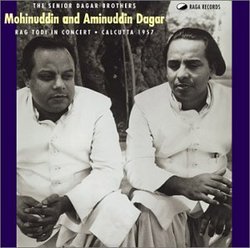Stunning performance transports you to another time & place
S. Naimpally | Dallas, TX USA | 09/28/2008
(5 out of 5 stars)
"Raga Todi is a morning raga and this rendering by the senior Dagar brothers is breathtaking in its intensity. The raga is developed unhurriedly and methodically in the Dhrupad-style. Most North Indian vocalists sing in the Khayal-style these days so it is refreshing to not only hear this raga in Dhrupad-style, but the added power of two vocalists makes it a very rare treat. John Wilton of Raga Records has released another in a series of "must have" recordings for conniseurs of Indian classical music. Not to be missed.
The recording appears to have been made at a house concert ("baithak") in Kolkotta. The quality of the recording is quite good considering how old the recording is and the state of the art at that time. Close your eyes and the intimacy of this recording transports you back to Kolkotta in 1957."
The Music of the Universe...
Giordano Bruno | Wherever I am, I am. | 10/04/2008
(5 out of 5 stars)
"... is not audible, according to Indian tradition, but through 'anhata' (performed music) harmony between humanity and the inaudible universe can be created. Singers can thus evoke thoughts beyond our conscious ability to think. Over the course of many centuries, Indian musicians have developed numerous devotional forms based on the Vedas, from simple hymns to the virtuosic improvisational singing of 'dhrupad', the art recorded on this historic CD from 1957.
Recording technology arrived in the audible world just in the nick of time to preserve the voices of the elder Dagar Brothers, Zahiruddin and Faiyazuddin. Imagine that the organ improvisations of Bach and Handel had been recorded, and you'll have a point of comparison. The elder Dagar Brothers were the nineteenth unbroken generation of a family utterly devoted to vocal music. Even the family name essentially means one medieval school of singers, the Dagarbani. Dozens of recordings of the brothers were made, and quite a few are available used for substantial prices; this CD has the advantage over the others of being available for a modest price. There is also an MP3, with the usual samples. However, a 90-second sample of 'Rag Todi' is comparable to stopping for gas on the road to the Grand Canyon and then claiming you've seen it.
A raga as sung by the Dagar Brothers is always divided into an 'alap' - a slowly evolving penetration into the melodic sequence, accompanied by a modal drone on the four-string instrument, the tanpura, which sets a recurring pulse. It's said that the soloists "sing on the waves of the tanpura." The alap is followed by the dhrupad, sung in Sanskrit, the improvisation channeled into a rushing stream both by the scale of the raga and the rhythm of the "tala" added by a fourth musician on a drum played with the hands. The drum usually preferred by the Dagars is the "pakhavaj," with skins on both ends of its frame. It's a softer sound than the more common "tabla" used with the sitar and sarod.
Here's a translation of the dhrupad sung by the Dagars on another fine CD, Raga Miyan ki Todi:
"Clever you are, oh mind of mine, knowing all about ragas and nuances of speech, but do not delude yourself. This, the primal sound, is too deep for us, inscrutable and beyond knowledge. To grasp it, you need not learning, but grace."
The art of the Dagar Brothers is humbling in its serenity."


 Track Listings (3) - Disc #1
Track Listings (3) - Disc #1